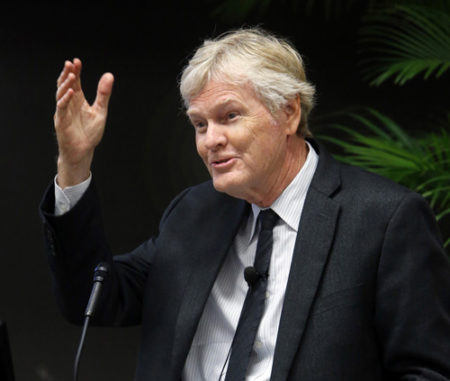As a child growing up in Miami, Michael Young, PhD, marveled at the “four o’clock flowers” in his neighbor’s yard. What caused its blossoms to shrivel against the day-time heat, and open four hours later when the sun set?

Six decades and a Nobel Prize later, Young, the Richard and Jeanne Fisher Professor and head of the Laboratory of Genetics at The Rockefeller University, is still trying to figure out what drives these “rhythms of life.”
Young, who shared the 2017 Nobel Prize in Physiology or Medicine with two Brandeis University geneticists for their groundbreaking studies of circadian rhythms, came to Vanderbilt University Medical Center last week to discuss his research as part of the Flexner Discovery Lecture series.
Addressing a packed Light Hall lecture room, Young described how his team identified six genes in the fruit fly, Drosophila, that are involved in forming a “biological oscillator.” Interactions among “clock genes” contribute to a network of molecular oscillations in cells throughout the body — and throughout the animal kingdom.
Young’s lab recently identified a variation in the cryptochrome, or CRY gene, that is associated with a prevalent human sleep disorder called delayed sleep phase disorder. DSPD is characterized by a persistent delay in the timing of sleep.
Genetic studies suggest an estimated one in every 75 individuals of non-Finnish European ancestry may carry the CRY variant. “This may account for as much as 20 percent of the DSPD that’s out there,” he said.
Young ended his lecture by thanking his colleagues and “the real hero” — the fruit fly Drosophila.
Arguably, so is the plant from his youth, Mirabilis. Turns out the four o’clock flower has evolved a circadian rhythm that allows it to conserve moisture during the day, and then open at night when the moth that pollinates its blossoms is active.
That observation prompted a question from the audience. What is the evolutionary value for conserving a genetic variation that causes a major sleep disorder?
Changes in the biological clock are not limited to sleep, Young pointed out. They potentially affect tissues throughout the body. Other researchers have found that overexpression of the CRY gene in mice produces dramatic changes in glucose metabolism.
“It could be that there’s a metabolic advantage … rather than anything that has to do with behavior,” he said. “The behavior (sleep disruption) is just something you have to live with to enjoy that advantage.”
For a complete schedule of Flexner Discovery Lectures and archived video of this and previous lectures, go to http://www.mc.vanderbilt.edu/discoveryseries.












